
Common and Notable Bird Species Observed During Louisiana Swamp Tours
Milton Walker Jr., owner of Louisiana Tour Company in Marrero, Louisiana, emphasizes the role of birdwatching in the overall swamp tour experience. “Many visitors come for the landscape or the chance to see alligators, but they often leave talking about the birds,” said Walker. “The swamp is alive with motion from species that range from large wading birds to songbirds and raptors.”
The Great Egret is among the most commonly spotted birds in the Louisiana wetlands. With its long neck, yellow bill, and elegant white plumage, this wading bird is often seen standing motionless in shallow water, stalking small fish and amphibians. Closely related are the Snowy Egret and Cattle Egret, each distinguished by size and feather detail.
Another signature bird of the swamp is the Great Blue Heron. This tall, slate-gray wader frequents the water’s edge and often takes slow, deliberate steps while hunting. With a wingspan approaching six feet, its takeoff is frequently noted as a highlight during boat tours.
Roseate Spoonbills add a burst of color to the swamp’s more muted tones. Recognizable by their bright pink feathers and spoon-shaped bills, these birds sweep their heads side-to-side in search of insects, crustaceans, and small aquatic creatures. Their feeding behavior and distinct appearance draw attention from both casual observers and avid birders.
Anhingas are another frequent presence. Sometimes called “snake birds” due to their long necks and swimming style, anhingas dive underwater to pursue fish and are often seen perched with wings spread to dry. Unlike ducks, anhingas lack the oils that allow feathers to repel water, making sunning a necessary behavior after diving.
The wetlands also provide habitat for several species of hawks and owls. The Red-shouldered Hawk, with its banded tail and piercing cry, often roosts in trees overlooking the bayou, while Barred Owls may be heard calling during late afternoon or early evening tours. Though more elusive, sightings of these raptors provide a deeper sense of the swamp’s biodiversity.
Belted Kingfishers are another notable species, often seen hovering above the water before plunging down to catch fish. Their rattling call and crest-like head feathers make them easily distinguishable from other birds of similar size.
Ibis species are also present in Louisiana swamps, especially the White Ibis, with its down-curved red bill and stark white plumage. These birds forage in groups, poking through mud and shallow water in search of food. Glossy Ibis and White-faced Ibis may also appear, particularly during migration seasons.
Wood Ducks inhabit swampy forested areas and nest in tree cavities near water. Males display iridescent green and chestnut plumage, while females are marked by a subtle white eye-ring. These ducks are considered an indicator species for healthy swamp ecosystems and are typically observed in quieter, shaded sections of the bayou.
Purple Gallinules and Common Gallinules navigate dense vegetation near the edges of the swamp. Recognizable by their colorful plumage and long toes adapted for walking across floating plants, these birds demonstrate the adaptability of avian species in marsh environments.
During migration seasons, Louisiana swamps host various songbirds, warblers, and swallows. Spring and fall bring added diversity to the area, with species passing through on their north-south journeys. The Prothonotary Warbler, a bright yellow bird often called the “swamp canary,” nests in cavities and is frequently heard before it is seen.
Ospreys and Bald Eagles are occasionally spotted, particularly near open waterways where fish are abundant. While these raptors require more space and elevation for nesting, they do make appearances in certain swamp areas, especially near lakes or river outlets.
Seasonal changes also affect bird visibility. Warmer months often bring more waterfowl and active feeding behavior, while winter months draw different species, including migratory ducks and geese. Weather patterns and water levels influence feeding, nesting, and roosting behaviors, resulting in variation in bird activity from one tour to the next.
Bird observation adds a dynamic layer to the swamp tour experience. Each bird sighting highlights the ecological complexity of Louisiana’s wetlands and serves as a reminder of the role these habitats play in supporting avian diversity. Preservation of these environments ensures continued nesting, migration, and feeding grounds for both common and less frequently observed species.
Louisiana swamp tours provide a unique platform for exploring not only the waterways and plant life of the region, but also the rich birdlife that calls it home. With each tour offering a different combination of sightings based on season, time of day, and weather, the birdwatching experience remains an essential part of the region’s ecotourism appeal.
Morgan Thomas
Rhino Digital, LLC
+1 504-875-5036
email us here
Visit us on social media:
Facebook
Distribution channels: Agriculture, Farming & Forestry Industry, Culture, Society & Lifestyle, Environment, Travel & Tourism Industry
Legal Disclaimer:
EIN Presswire provides this news content "as is" without warranty of any kind. We do not accept any responsibility or liability for the accuracy, content, images, videos, licenses, completeness, legality, or reliability of the information contained in this article. If you have any complaints or copyright issues related to this article, kindly contact the author above.
Submit your press release

